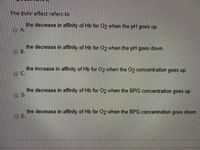
Biochemistry
9th Edition
ISBN: 9781319114671
Author: Lubert Stryer, Jeremy M. Berg, John L. Tymoczko, Gregory J. Gatto Jr.
Publisher: W. H. Freeman
expand_more
expand_more
format_list_bulleted
Concept explainers
Question

Transcribed Image Text:The Bohr effect refers to
the decrease in affinity of Hb for 02 when the pH goes up.
the decrease in affinity of Hb for 02 when the pH goes down.
O B.
the increase in affinity of Hb for 02 when the 02 concentration goes up.
OC.
the decrease in affinity of Hb for 02 when the BPG concentration goes up.
D.
the decrease in affinity of Hb for O2 when the BPG concentration goes down.
Expert Solution
This question has been solved!
Explore an expertly crafted, step-by-step solution for a thorough understanding of key concepts.
This is a popular solution
Trending nowThis is a popular solution!
Step by stepSolved in 2 steps

Knowledge Booster
Learn more about
Need a deep-dive on the concept behind this application? Look no further. Learn more about this topic, biochemistry and related others by exploring similar questions and additional content below.Similar questions
- Which factors will cause protein denaturation? Group of answer choices a. aqueous phosphate buffer b. heavy metals - Hg2+, Pb2+, Ag+ c. small metal ions - Na+, Ca2+, Cl- d. changes in pH e. use of detergents or soaps f. Tris a buffer commonly used with proteinsarrow_forwardThe greater the pKa of an acid, the _________ the acid is. Stronger or weaker?arrow_forwardMary is severely dehydrated from multiple and prolonged bouts of diarrhea. Her labs are returned. pH - 7.3 (normal 7.4) PACO2 = 33mmHg (normal 40mmHg) [Na} - 140mEq/L -normal HCO3- = 16mEq/L (normal) metabolic acidosis O metabolic akalosis respiratory acidosis O respiratory alkalosisarrow_forward
- Based on the Henderson-Hasselbalch equation (shown below), calculate the pH when half of a solution of acetic acid is dissociated to acetate (the pKa of acetic acid is 4.76). A. 1.00 B. 3.76 C. 4.76 D. 5.76arrow_forwardA scientist extracted compounds from apple peel and separated them using gel exclusion chromatography. Indicate which would be the expected order of elution from first eluted to last.arrow_forwardBuffer systems can absorb hydrogen ions from the blood to increase pH into homeostatic range (pH: 7.35 to 7.45)During what condition would buffer systems do this?arrow_forward
- The side chain of acetyl-L-lysine-OMe has a pKa=10.5 and its acid-dissociation reaction is shown below. see attachment for Question D.arrow_forwardge Which of the following statements regarding Osmotic pressure is most accurate: Select one: O a. The number of particles does not determine the osmotic pressure O b. The more particles, the lower the osmotic pressure O c. The more particles, the higher the osmotic pressure O d. The less particles, the lower the osmotic pressure Q Search OLD 斯斯 --- 1 acer E 9 Time Narrow_forwardUse a calculation based on the pH partition model to determine the likelihood that a weakly acidic drug of pKa= 3.0 will be absorbed passively from the stomach (pH = 2.3) or from the small intestine (pH = 5.0). The pH of the blood is 7.4 .arrow_forward
- The most important factor guaranteeing a biochemical change is a. A positive ∆G b. Appropriate temperature c. A negative ∆S d. A negative ∆Garrow_forwardWhich way does the ion move and why? Na+ F=23100 cal/V*mol Vm = -60mV R =2cal/mol*K T = 300K Inside 50mM Outside 150mM A. Into the cell due to charge and concentration B. Out of the cell due to charge and concentration C. Out of the cell due to charge D. Into the cell due to concentration.arrow_forwardBased on the Henderson-Hasselbalch equation (shown below), calculate the pH when the ratio of acetic acid to acetate is 10 to 1 (the pKa of acetic acid is 4.76). A. 1.00 B. 3.76 C. 4.76 D. 5.76arrow_forward
arrow_back_ios
SEE MORE QUESTIONS
arrow_forward_ios
Recommended textbooks for you
 BiochemistryBiochemistryISBN:9781319114671Author:Lubert Stryer, Jeremy M. Berg, John L. Tymoczko, Gregory J. Gatto Jr.Publisher:W. H. Freeman
BiochemistryBiochemistryISBN:9781319114671Author:Lubert Stryer, Jeremy M. Berg, John L. Tymoczko, Gregory J. Gatto Jr.Publisher:W. H. Freeman Lehninger Principles of BiochemistryBiochemistryISBN:9781464126116Author:David L. Nelson, Michael M. CoxPublisher:W. H. Freeman
Lehninger Principles of BiochemistryBiochemistryISBN:9781464126116Author:David L. Nelson, Michael M. CoxPublisher:W. H. Freeman Fundamentals of Biochemistry: Life at the Molecul...BiochemistryISBN:9781118918401Author:Donald Voet, Judith G. Voet, Charlotte W. PrattPublisher:WILEY
Fundamentals of Biochemistry: Life at the Molecul...BiochemistryISBN:9781118918401Author:Donald Voet, Judith G. Voet, Charlotte W. PrattPublisher:WILEY BiochemistryBiochemistryISBN:9781305961135Author:Mary K. Campbell, Shawn O. Farrell, Owen M. McDougalPublisher:Cengage Learning
BiochemistryBiochemistryISBN:9781305961135Author:Mary K. Campbell, Shawn O. Farrell, Owen M. McDougalPublisher:Cengage Learning BiochemistryBiochemistryISBN:9781305577206Author:Reginald H. Garrett, Charles M. GrishamPublisher:Cengage Learning
BiochemistryBiochemistryISBN:9781305577206Author:Reginald H. Garrett, Charles M. GrishamPublisher:Cengage Learning Fundamentals of General, Organic, and Biological ...BiochemistryISBN:9780134015187Author:John E. McMurry, David S. Ballantine, Carl A. Hoeger, Virginia E. PetersonPublisher:PEARSON
Fundamentals of General, Organic, and Biological ...BiochemistryISBN:9780134015187Author:John E. McMurry, David S. Ballantine, Carl A. Hoeger, Virginia E. PetersonPublisher:PEARSON

Biochemistry
Biochemistry
ISBN:9781319114671
Author:Lubert Stryer, Jeremy M. Berg, John L. Tymoczko, Gregory J. Gatto Jr.
Publisher:W. H. Freeman

Lehninger Principles of Biochemistry
Biochemistry
ISBN:9781464126116
Author:David L. Nelson, Michael M. Cox
Publisher:W. H. Freeman

Fundamentals of Biochemistry: Life at the Molecul...
Biochemistry
ISBN:9781118918401
Author:Donald Voet, Judith G. Voet, Charlotte W. Pratt
Publisher:WILEY

Biochemistry
Biochemistry
ISBN:9781305961135
Author:Mary K. Campbell, Shawn O. Farrell, Owen M. McDougal
Publisher:Cengage Learning

Biochemistry
Biochemistry
ISBN:9781305577206
Author:Reginald H. Garrett, Charles M. Grisham
Publisher:Cengage Learning

Fundamentals of General, Organic, and Biological ...
Biochemistry
ISBN:9780134015187
Author:John E. McMurry, David S. Ballantine, Carl A. Hoeger, Virginia E. Peterson
Publisher:PEARSON